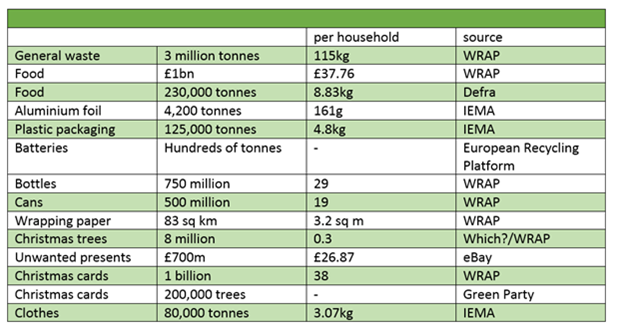Christmas 2020: Let's prioritize Environment
Total Views | 306
"Don’t be scared to try something new during Christmas season by giving up the hazardous elements. Save Earth."

Christmas is by far one of the busiest and most celebrated holidays. It is the time people spend more money and eat the most food. In UK alone, people munch 370 million mince pies, 250 million pints of beer, 35 million bottles of wine and ten million turkeys. This means people eat 80 percent more food than during the rest of the year. The downside to this is that excess food waste and pollution during Christmas period.
Below is a table of the average extra waste generated over the Christmas period each year, based on January rubbish and recycling collections in UK.

There are also financial impacts as each household spend 170 pounds on festive food, despite 35% people admit that they throw more food away at Christmas than at any other time of the year.
As well as food, it is also important to think about the wrapping paper and packaging that one purchase, use and discard during the Christmas period. In 2016 it is reported 227,000 miles of wrapping paper thrown away, enough to wrap an island.
If one places all Christmas cards alongside one another, they would stretch around the world 500 times. People get through 4500 tonnes of tin foil and 125000 tonnes of plastic packaging during Christmas season
As little as one kilogram of wrapping paper emits three and a half kilograms of CO2 during its production process, taking around one and a half kilograms of coal to power its production. This does not take into account further packaging and transportation.
Many people have short-lived debates over buying fake or real Christmas trees, but this decision has consequences for the environment. Each year around eight million real Christmas trees are bought, with over five million households opting for artificial trees.
“Artificial trees have a carbon footprint equivalent to around 40kg of greenhouse gas emissions and the main material in artificial trees is plastic; they contribute to the plastic pollution problem around the world.”
As artificial Christmas trees are non-biodegradable, they are sent to landfill or are incinerated, which again, has a terrible impact on the environment via emissions. Often, artificial trees are produced in South Korea, Taiwan or China, and are shipped thousands of miles to get to your home.
In the US alone, between 25 and 30 million real Christmas trees are sold every year, according to the National Christmas Tree Association. While in Germany, around 27 million are felled for festivities each year.
No matter how many years you reuse an artificial tree, someday it will get thrown away and end up in a landfill for the next 1000 years!
Eighty percent (80%) of artificial trees worldwide are manufactured in China, according to the U.S. Commerce Department. Real Trees are a renewable, recyclable resource.
Artificial trees contain non-biodegradable plastics and possible metal toxins such as lead.
Christmas gift-giving produces massive annual economic waste, at that time estimated between $4-billion and $13-billion in the United States alone.
The staggering statistics about the environmental costs of global meat production – that it accounts for about 15-18% of total greenhouse gas emissions, or that it takes nearly 20,000 litres of water to produce 1kg of meat protein – are largely skewed by a few huge, high-intensity livestock industries (beef in particular).
Normal candles are made from paraffin, which is a byproduct of petroleum. So, burning fossil fuels will pollute the air and prove hazardous to environment.
More than 1 billion pounds of wax are used in producing the candles sold each year in the U.S. and U.S. retail sales of candle products are estimated at approximately $3.14 billion annually.
Bharati Web







